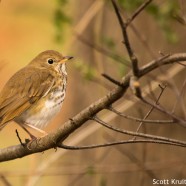American Kestrel Female
This female American Kestrel (Falco sparverius) perched on the wire just long enough for me to take a shot while we looked each other in the eye. She is a March migrant, one of many raptors on the move to the north every day now. She will be hunting slowly melting grasslands and fields under the soon to be spring sun. Do you have any American Kestrel nest boxes erected on your large open property or farm? Now is the time to get them up or cleaned. Scott Kruitbosch Conservation & Outreach Coordinator
Read MoreTrumpeter Swans (Cygnus buccinator)
Here in Chautauqua County we are accustomed to seeing Tundra Swans (Cygnus columbianus) throughout the migratory and wintering seasons. If you are very lucky you may someday be able to pick out a Trumpeter Swan (Cygnus buccinator) in similar habitats. The Trumpeter Swan, the largest of North America’s waterfowl, was nearly extinct in the early 20th century. Thankfully hunting for feathers for the quill pen market, among others, has ended and their numbers have rebounded. This is also due to hard work by the conservation community in North America. It can be very difficult to separate a...
Read MoreTurkey Devouring Bittersweet
What a Thanksgiving feast this Wild Turkey enjoyed! While we almost always expect our flocks of turkeys to be feeding on the ground on seeds, invertebrates, or even amphibians and reptiles, they can sometimes find food in other places. They do fly, after all! If you have never seen a group roosting in a tree in your yard or quickly taking off I recommend you keep an eye out for it because it is always a spectacle. In this case I watched a few of them in a tree feeding on bittersweet berries… What a resourceful bird! There is a reason their population has exploded across the Northeast...
Read MoreAutumn Hermit Thrush (Catharus guttatus)
This beautiful Hermit Thrush (Catharus guttatus) posed wonderfully for me in the shade earlier today, taking a quick break from foraging in mounds of leaf litter. They are a shy species that can be found on the edges of forests and woodlands, even your yard, if there is enough space and habitat for them to find insects. As we near the winter their diet is going to shift to include various berries. I was surprised to find several of them this weekend, possibly having moved south and been more boldly active given all of the cold temperatures lately. They will enjoy this warm-up making bug...
Read MoreWild Turkey: vicious predator
‘Tis now the season for the Wild Turkey (Meleagris gallopavo). I have been regularly spotting a couple of groups lately, one with around 18 individuals and another with around 8. Here is one bird passing through on a showery and cloudy afternoon. It is hard to believe how rapidly the species has expanded in many areas in the last couple of decades. Is their population increase partially responsible for a decrease in some woodlands herpetofauna? I posted a great deal about Timber Rattlesnakes (Crotalus horridus) this summer, and would you believe this very turkey is a potential...
Read More








